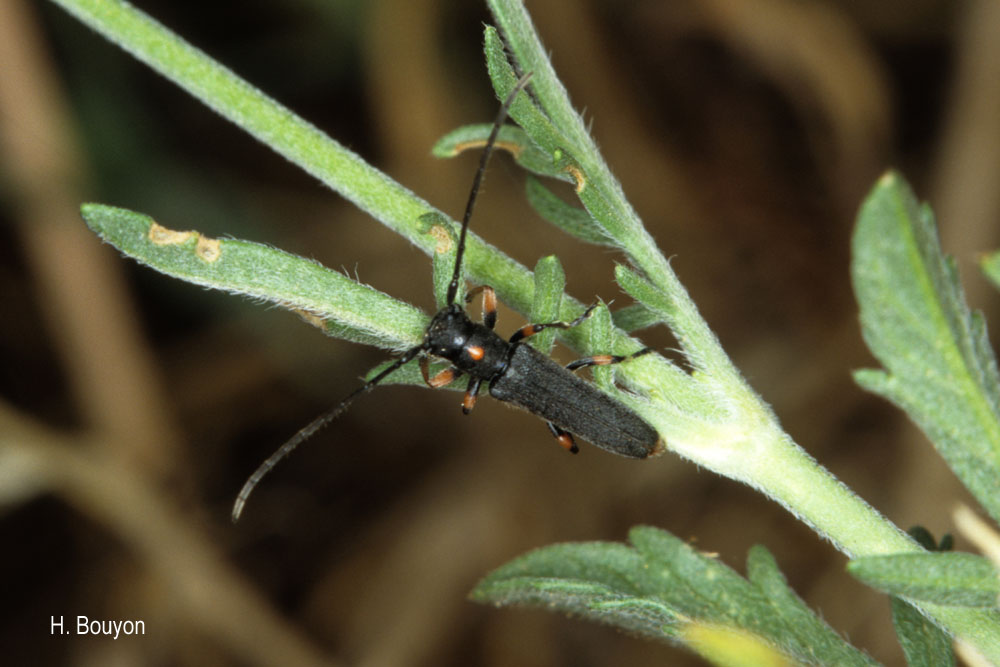
cd_nom

| Author : H.Bouyon |
 |
To get the picture, please visit:
Bouyon Hervé
herve.bouyon@wanadoo.fr
Any reuse of one or more photographs on this site is subject to an authorization request from the author.
Link to the Code of Intellectual Property (Legifrance)

| Author : H. Bouyon |
 |
To get the picture, please visit:
Any reuse of one or more photographs on this site is subject to an authorization request from the author.
Link to the Code of Intellectual Property (Legifrance)
Taille : 6 -12 mm
Longicorne à stature allongée au corps entièrement noir dont seuls les tibias antérieurs et les fémurs sur leur partie basale sont orangés. Le pronotum présente en son milieu une tache rouge orangé arrondie. Antennes noires aussi longues que le corps chez la femelle, plus longue chez le mâle. Le corps est entièrement recouvert d'une pubescence courte cendrée.
Confusion possible avec des Phytoecia à tache rouge sur le pronotum comme Phytoecia pustulata ou Phytoecia vulneris. Elle s'en distingue par la forme ronde de la tache et sa position un peu en avant du milieu.
Les adultes sont actifs d'avril à juillet.
La larve, phytophage, se développe dans les racines et au collet des plantes herbacées de la famille des Astéracées. Les adultes diurnes restent discrets sur les plantes nourricières.
Espèce distribuée dans la moitié sud de l'Europe, du Portugal à la Pologne, jusqu'au Moyen-Orient. En France, elle se rencontre dans les zones bien exposées dans les friches, les pelouses surtout en zone méditerranéenne mais remonte jusqu'en Ile-de-France.
D'après :
Berger, P. 2012. Coléoptères Cerambycidae de la faune de France continentale et de Corse - Actualisation de l'ouvrage d'André Villiers, 1978. Revue de l'Association Roussillonnaise d'Entomologie, supplément tome XXI, 664 p.
L. Valladares (EIPurpan (UMR INRA / INPT 1201 Dynafor)),2020
Continental
Metropolitan France
Overseas
Marine
Metropolitan France
Overseas
The map presents a summary at the 10 x 10 km grid of the observation data for the species transmitted to the SINP. These data have been subjected to validation filters.
The map presents a reference distribution layer of the species at the scale of departments and marine sectors. The presence and absence data were established by expertise within a network of partners. This reference distribution is used in the validation process of the SINP data at the INPN level.
Corresponds to a report on the basis of at least one observation proved within a period of 10 years (20 years for little-known invertebrates) preceding the year and no presumption of extinction since obtaining the last data nor doubt on reproductive and implemented nature of this population. For migratory species, the presence indicated concerns areas of reproduction.
This status is based on one or more of the following criteria:
This point covers the absence, more difficult by nature to demonstrate than presence. This status is based on one or more of the following criteria:
This status must be assigned to a department in which the presence of the species is casual.
Particular case of absence due to a proven extinction less than a half century ago (older disappearances are treated as "no probable or definite").
In the state of knowledge, we can not comment on the presence or absence in the current department. This is the default status when not comprised in one of the previous categories or whenever there is doubt.
The map shows the global distribution of the species based on GBIF data (Global Biodiversity Information Facility).
